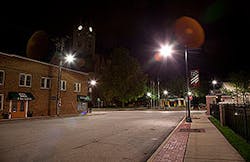DOE Shelves Energy Conservation Standards for HID
The Energy Policy and Conservation Act of 1975 (EPCA), as amended, requires DOE to prescribe test procedures and energy conservation standards for HID lamps for which it has determined that standards would be technologically feasible and economically justified, and would result in significant energy savings. In this final determination, DOE determines that energy conservation standards for HID lamps do not meet these criteria.
Said the DOE in the ruling, “Specifically, DOE concludes that standards for high-pressure sodium (HPS) lamps are not technologically feasible, and that standards for mercury vapor (MV) and metal halide (MH) lamps are not economically justified (HPS, MV, and MH lamps are subcategories of HID lamps). DOE’s determination is based on analysis of several efficacy levels as a means of conserving energy.”
About the Author
Doug Chandler, Senior Staff Writer
Executive Editor
Doug Chandler began writing about the electrical industry in 1992, and still finds there's never a shortage of stories to be told. So he spends his days finding them and telling them. Educationally, he's a Jayhawk with an English degree. Outside of work, he can often be found banging drums or harvesting tomatoes.

